Jinan Xu
A Dual-Space Framework for General Knowledge Distillation of Large Language Models
Apr 15, 2025Abstract:Knowledge distillation (KD) is a promising solution to compress large language models (LLMs) by transferring their knowledge to smaller models. During this process, white-box KD methods usually minimize the distance between the output distributions of the teacher model and the student model to transfer more information. However, we reveal that the current white-box KD framework exhibits two limitations: a) bridging probability distributions from different output spaces will limit the similarity between the teacher model and the student model; b) this framework cannot be applied to LLMs with different vocabularies. One of the root causes for these limitations is that the distributions from the teacher and the student for KD are output by different prediction heads, which yield distributions in different output spaces and dimensions. Therefore, in this paper, we propose a dual-space knowledge distillation (DSKD) framework that unifies the prediction heads of the teacher and the student models for KD. Specifically, we first introduce two projectors with ideal initialization to project the teacher/student hidden states into the student/teacher representation spaces. After this, the hidden states from different models can share the same head and unify the output spaces of the distributions. Furthermore, we develop an exact token alignment (ETA) algorithm to align the same tokens in two differently-tokenized sequences. Based on the above, our DSKD framework is a general KD framework that supports both off-policy and on-policy KD, and KD between any two LLMs regardless of their vocabularies. Extensive experiments on instruction-following, mathematical reasoning, and code generation benchmarks show that DSKD significantly outperforms existing methods based on the current white-box KD framework and surpasses other cross-tokenizer KD methods for LLMs with different vocabularies.
D2C: Unlocking the Potential of Continuous Autoregressive Image Generation with Discrete Tokens
Mar 21, 2025Abstract:In the domain of image generation, latent-based generative models occupy a dominant status; however, these models rely heavily on image tokenizer. To meet modeling requirements, autoregressive models possessing the characteristics of scalability and flexibility embrace a discrete-valued tokenizer, but face the challenge of poor image generation quality. In contrast, diffusion models take advantage of the continuous-valued tokenizer to achieve better generation quality but are subject to low efficiency and complexity. The existing hybrid models are mainly to compensate for information loss and simplify the diffusion learning process. The potential of merging discrete-valued and continuous-valued tokens in the field of image generation has not yet been explored. In this paper, we propose D2C, a novel two-stage method to enhance model generation capacity. In the first stage, the discrete-valued tokens representing coarse-grained image features are sampled by employing a small discrete-valued generator. Then in the second stage, the continuous-valued tokens representing fine-grained image features are learned conditioned on the discrete token sequence. In addition, we design two kinds of fusion modules for seamless interaction. On the ImageNet-256 benchmark, extensive experiment results validate that our model achieves superior performance compared with several continuous-valued and discrete-valued generative models on the class-conditional image generation tasks.
OmniGeo: Towards a Multimodal Large Language Models for Geospatial Artificial Intelligence
Mar 20, 2025Abstract:The rapid advancement of multimodal large language models (LLMs) has opened new frontiers in artificial intelligence, enabling the integration of diverse large-scale data types such as text, images, and spatial information. In this paper, we explore the potential of multimodal LLMs (MLLM) for geospatial artificial intelligence (GeoAI), a field that leverages spatial data to address challenges in domains including Geospatial Semantics, Health Geography, Urban Geography, Urban Perception, and Remote Sensing. We propose a MLLM (OmniGeo) tailored to geospatial applications, capable of processing and analyzing heterogeneous data sources, including satellite imagery, geospatial metadata, and textual descriptions. By combining the strengths of natural language understanding and spatial reasoning, our model enhances the ability of instruction following and the accuracy of GeoAI systems. Results demonstrate that our model outperforms task-specific models and existing LLMs on diverse geospatial tasks, effectively addressing the multimodality nature while achieving competitive results on the zero-shot geospatial tasks. Our code will be released after publication.
AlignDistil: Token-Level Language Model Alignment as Adaptive Policy Distillation
Mar 04, 2025Abstract:In modern large language models (LLMs), LLM alignment is of crucial importance and is typically achieved through methods such as reinforcement learning from human feedback (RLHF) and direct preference optimization (DPO). However, in most existing methods for LLM alignment, all tokens in the response are optimized using a sparse, response-level reward or preference annotation. The ignorance of token-level rewards may erroneously punish high-quality tokens or encourage low-quality tokens, resulting in suboptimal performance and slow convergence speed. To address this issue, we propose AlignDistil, an RLHF-equivalent distillation method for token-level reward optimization. Specifically, we introduce the reward learned by DPO into the RLHF objective and theoretically prove the equivalence between this objective and a token-level distillation process, where the teacher distribution linearly combines the logits from the DPO model and a reference model. On this basis, we further bridge the accuracy gap between the reward from the DPO model and the pure reward model, by building a contrastive DPO reward with a normal and a reverse DPO model. Moreover, to avoid under- and over-optimization on different tokens, we design a token adaptive logit extrapolation mechanism to construct an appropriate teacher distribution for each token. Experimental results demonstrate the superiority of our AlignDistil over existing methods and showcase fast convergence due to its token-level distributional reward optimization.
Warmup-Distill: Bridge the Distribution Mismatch between Teacher and Student before Knowledge Distillation
Feb 17, 2025Abstract:The widespread deployment of Large Language Models (LLMs) is hindered by the high computational demands, making knowledge distillation (KD) crucial for developing compact smaller ones. However, the conventional KD methods endure the distribution mismatch issue between the teacher and student models, leading to the poor performance of distillation. For instance, the widely-used KL-based methods suffer the mode-averaging and mode-collapsing problems, since the mismatched probabitliy distribution between both models. Previous studies mainly optimize this issue via different distance calculations towards the distribution of both models. Unfortunately, the distribution mismatch issue still exists in the early stage of the distillation. Hence, to reduce the impact of distribution mismatch, we propose a simple yet efficient method, named Warmup-Distill, which aligns the distillation of the student to that of the teacher in advance of distillation. Specifically, we first detect the distribution of the student model in practical scenarios with its internal knowledge, and then modify the knowledge with low probability via the teacher as the checker. Consequently, Warmup-Distill aligns the internal student's knowledge to that of the teacher, which expands the distribution of the student with the teacher's, and assists the student model to learn better in the subsequent distillation. Experiments on the seven benchmarks demonstrate that Warmup-Distill could provide a warmup student more suitable for distillation, which outperforms the vanilla student by as least +0.4 averaged score among all benchmarks. Noteably, with the assistance of Warmup-Distill, the distillation on the math task could yield a further improvement, at most +1.9% accuracy.
Migician: Revealing the Magic of Free-Form Multi-Image Grounding in Multimodal Large Language Models
Jan 13, 2025



Abstract:The recent advancement of Multimodal Large Language Models (MLLMs) has significantly improved their fine-grained perception of single images and general comprehension across multiple images. However, existing MLLMs still face challenges in achieving precise grounding in complex multi-image scenarios. To address this, we first explore a Chain-of-Thought (CoT) framework that integrates single-image grounding with multi-image comprehension. While partially effective, it remains unstable and struggles to capture abstract visual information due to its non-end-to-end nature. Therefore, we introduce Migician, the first multi-image grounding model capable of performing free-form and accurate grounding across multiple images. To support this, we present the MGrounding-630k dataset, which comprises data for several multi-image grounding tasks derived from existing datasets, along with newly generated free-form grounding instruction-following data. Furthermore, we propose MIG-Bench, a comprehensive benchmark specifically designed for evaluating multi-image grounding capabilities. Experimental results demonstrate that our model achieves significantly superior multi-image grounding capabilities, outperforming the best existing MLLMs by 21.61% and even surpassing much larger 70B models. Our code, model, dataset, and benchmark are fully open-sourced at https://migician-vg.github.io/.
Beyond Binary Gender: Evaluating Gender-Inclusive Machine Translation with Ambiguous Attitude Words
Jul 23, 2024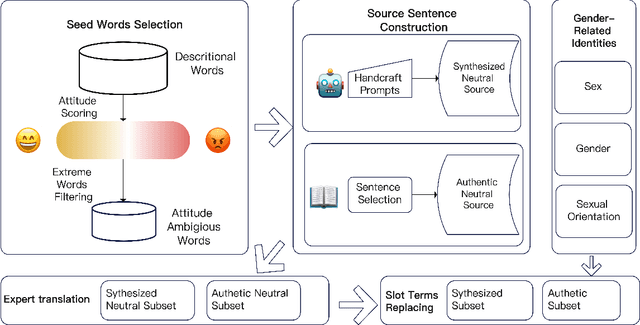

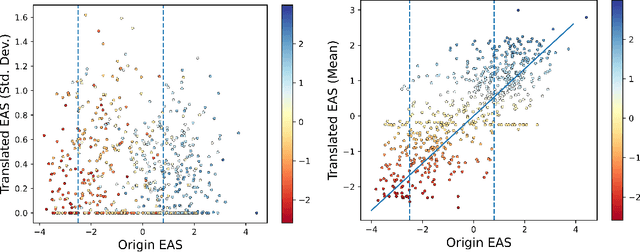

Abstract:Gender bias has been a focal point in the study of bias in machine translation and language models. Existing machine translation gender bias evaluations are primarily focused on male and female genders, limiting the scope of the evaluation. To assess gender bias accurately, these studies often rely on calculating the accuracy of gender pronouns or the masculine and feminine attributes of grammatical gender via the stereotypes triggered by occupations or sentiment words ({\em i.e.}, clear positive or negative attitude), which cannot extend to non-binary groups. This study presents a benchmark AmbGIMT (Gender-Inclusive Machine Translation with Ambiguous attitude words), which assesses gender bias beyond binary gender. Meanwhile, we propose a novel process to evaluate gender bias based on the Emotional Attitude Score (EAS), which is used to quantify ambiguous attitude words. In evaluating three recent and effective open-source LLMs and one powerful multilingual translation-specific model, our main observations are: (1) The translation performance within non-binary gender contexts is markedly inferior in terms of translation quality and exhibits more negative attitudes than binary-gender contexts. (2) The analysis experiments indicate that incorporating constraint context in prompts for gender identity terms can substantially reduce translation bias, while the bias remains evident despite the presence of the constraints. The code is publicly available at \url{https://github.com/pppa2019/ambGIMT}.
Dual-Space Knowledge Distillation for Large Language Models
Jun 25, 2024
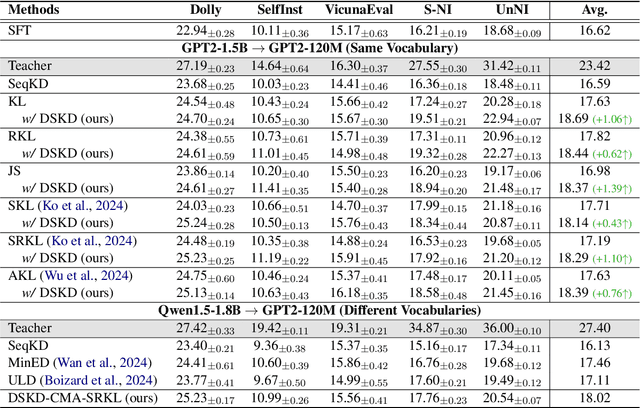


Abstract:Knowledge distillation (KD) is known as a promising solution to compress large language models (LLMs) via transferring their knowledge to smaller models. During this process, white-box KD methods usually minimize the distance between the output distributions of the two models so that more knowledge can be transferred. However, in the current white-box KD framework, the output distributions are from the respective output spaces of the two models, using their own prediction heads. We argue that the space discrepancy will lead to low similarity between the teacher model and the student model on both representation and distribution levels. Furthermore, this discrepancy also hinders the KD process between models with different vocabularies, which is common for current LLMs. To address these issues, we propose a dual-space knowledge distillation (DSKD) framework that unifies the output spaces of the two models for KD. On the basis of DSKD, we further develop a cross-model attention mechanism, which can automatically align the representations of the two models with different vocabularies. Thus, our framework is not only compatible with various distance functions for KD (e.g., KL divergence) like the current framework, but also supports KD between any two LLMs regardless of their vocabularies. Experiments on task-agnostic instruction-following benchmarks show that DSKD significantly outperforms the current white-box KD framework with various distance functions, and also surpasses existing KD methods for LLMs with different vocabularies.
Multilingual Knowledge Editing with Language-Agnostic Factual Neurons
Jun 24, 2024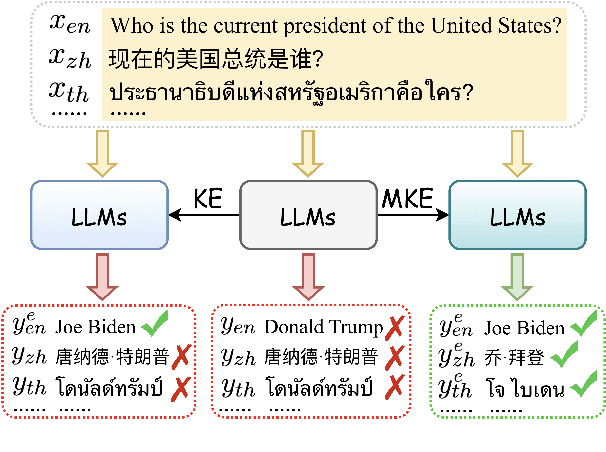
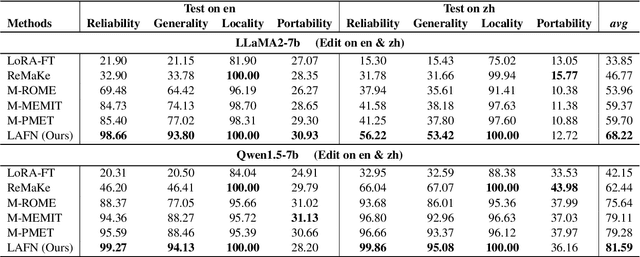
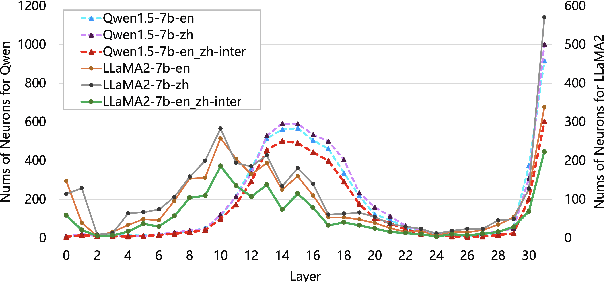

Abstract:Multilingual knowledge editing (MKE) aims to simultaneously revise factual knowledge across multilingual languages within large language models (LLMs). However, most existing MKE methods just adapt existing monolingual editing methods to multilingual scenarios, overlooking the deep semantic connections of the same factual knowledge between different languages, thereby limiting edit performance. To address this issue, we first investigate how LLMs represent multilingual factual knowledge and discover that the same factual knowledge in different languages generally activates a shared set of neurons, which we call language-agnostic factual neurons. These neurons represent the semantic connections between multilingual knowledge and are mainly located in certain layers. Inspired by this finding, we propose a new MKE method by locating and modifying Language-Agnostic Factual Neurons (LAFN) to simultaneously edit multilingual knowledge. Specifically, we first generate a set of paraphrases for each multilingual knowledge to be edited to precisely locate the corresponding language-agnostic factual neurons. Then we optimize the update values for modifying these located neurons to achieve simultaneous modification of the same factual knowledge in multiple languages. Experimental results on Bi-ZsRE and MzsRE benchmarks demonstrate that our method outperforms existing MKE methods and achieves remarkable edit performance, indicating the importance of considering the semantic connections among multilingual knowledge.
Outdated Issue Aware Decoding for Factual Knowledge Editing
Jun 06, 2024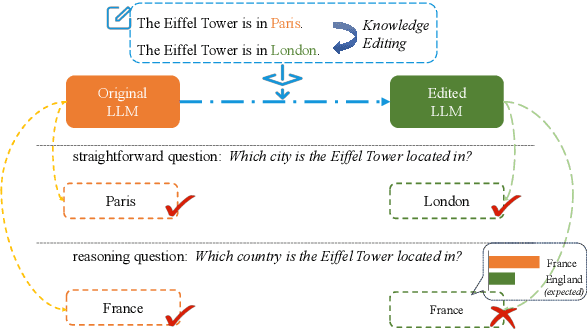
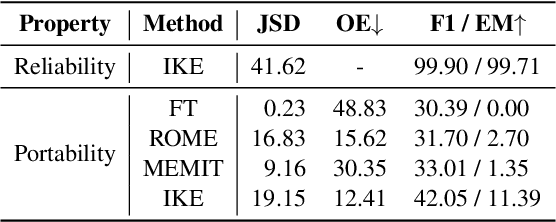
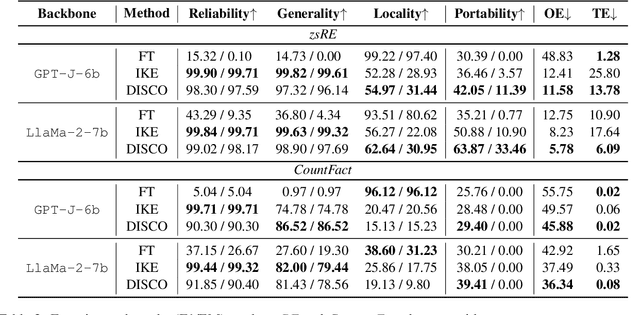
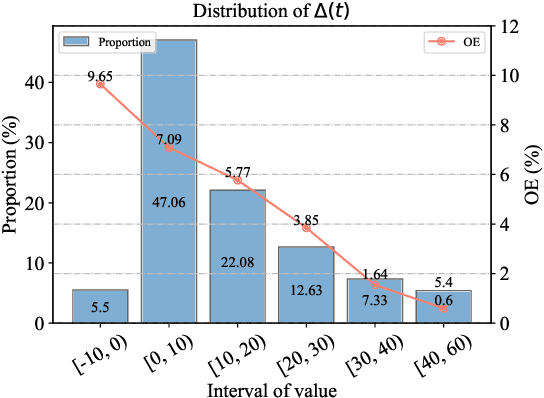
Abstract:Recently, Knowledge Editing has received increasing attention, since it could update the specific knowledge from outdated ones in pretrained models without re-training. However, as pointed out by recent studies, existing related methods tend to merely memorize the superficial word composition of the edited knowledge, rather than truly learning and absorbing it. Consequently, on the reasoning questions, we discover that existing methods struggle to utilize the edited knowledge to reason the new answer, and tend to retain outdated responses, which are generated by the original models utilizing original knowledge. Nevertheless, the outdated responses are unexpected for the correct answers to reasoning questions, which we named as the outdated issue. To alleviate this issue, in this paper, we propose a simple yet effective decoding strategy, i.e., outDated ISsue aware deCOding (DISCO), to enhance the performance of edited models on reasoning questions. Specifically, we capture the difference in the probability distribution between the original and edited models. Further, we amplify the difference of the token prediction in the edited model to alleviate the outdated issue, and thus enhance the model performance w.r.t the edited knowledge. Experimental results suggest that applying DISCO could enhance edited models to reason, e.g., on reasoning questions, DISCO outperforms the prior SOTA method by 12.99 F1 scores, and reduces the ratio of the outdated issue to 5.78% on the zsRE dataset.
 Add to Chrome
Add to Chrome Add to Firefox
Add to Firefox Add to Edge
Add to Edge